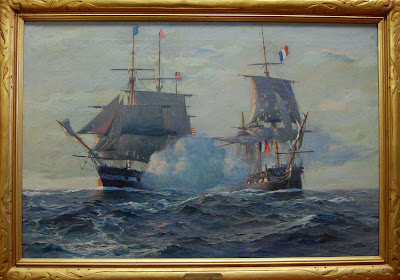On This Day in History: Secretary of the Navy Orders Construction of Naval Torpedo Station
 |
| Illustration of Naval Torpedo Station, 1876 |
On this day in 1869, Secretary of the Navy Adolph E. Borie
ordered the construction of the Naval Torpedo Station (NTS) on Goat Island in
Newport. The NTS was the first U.S. Navy installation dedicated to manufacturing
torpedoes, experimenting with new designs, and instructing personnel in their
use. It provided the bulk of the Navy’s torpedoes through two world wars and operated
continuously until closing in 1951, although its research and development
activities continue today at the Naval Undersea Warfare Center.
During the Civil War, twenty-eight ships sank from contacting
torpedoes. These weapons fell into two categories: stationary floating torpedoes
(mines in today’s parlance) and spar torpedoes. The latter consisted of an
explosive charge secured to the end of a long pole that jutted out over the bow
of the vessel that carried it. The attacker had to ram the torpedo into the
side of an enemy ship and then manually detonate the explosive with a trigger
mechanism. While effective if properly delivered, they required the crew to
expose themselves to enemy fire as well as the explosive force of the torpedo
itself.
The Navy established the NTS to develop new torpedoes that
were both more deadly and put the operator at less risk. Much of the early work
at the NTS built upon the success of a British designer named Robert Whitehead
who, in 1866, produced the world’s first “automobile torpedo.” Whitehead’s
design could be launched from a ship and carried an eighteen pound charge for
700 yards at six knots. By 1871, the NTS debuted an improved version of the
Whitehead torpedo known as the Fish. Another design known as the Howell torpedo
became the first self-propelled weapon issued to the U.S. Navy in 1889.
Initially, NTS designers worked on both automobile torpedoes
and mines. The U.S. Army Corps of Engineers took over responsibility for mines
between 1871 and the start of World War I as part of their mission to provide
for the fixed defenses of America’s harbors. This left NTS free to concentrate
on self-propelled designs at a time when the Navy was undergoing the most
radical transformation in its history. The old wooden warships of the Civil War
navy were gradually being replaced by new steel ships that carried their guns
in turrets and could operate under steam or sail. While rifled guns still ruled
the day in battle, improvements in torpedo design made them a greater threat to
capital ships. They became especially dangerous when they were mounted on small,
fast-moving vessels called torpedo boats that could dart in close to launch
their weapons and moved too quickly to be targeted by the guns of their quarry.
During the early years of its existence, students at the
Naval War College spent a great deal of time studying the question of how best
to employ torpedoes. When a reporter from Frank
Leslie’s Illustrated Newspaper visited the school in 1888, he noted that the
classes used war games to try to predict the impact of new technology on naval
tactics and strategy:
“While the cruisers
and torpedo-boats of the new navy are developing at the ship-yards, the
officers who are to manoeuvre these engines of modern warfare in the future are
equipping themselves with practical experiments, and seeing service by means of
imaginary combats on the chart and blackboard.”
Future innovations such as submarines and aircraft would
further disrupt conventional thinking about the best ways to use torpedoes.
From 1869 to 1951, the NTS served as the premier facility for manufacturing and
experimenting with these weapons.
Rob Doane
Curator, Naval War College Museum




Comments
Post a Comment